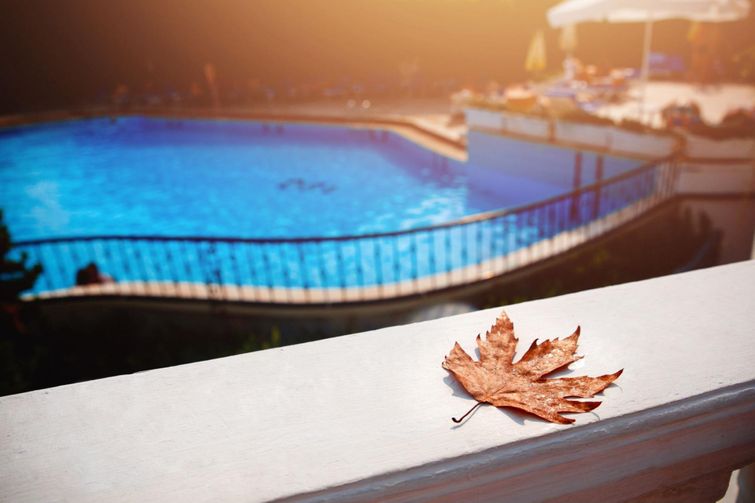
While many Canadians enjoy the winter season’s cold temperatures, they can be detrimental to both inground and above-ground pools. Freezing water can negatively impact above and inground pools’ equipment and conditions. Leaving a pool open during the winter months can also be dangerous to people and animals. Protect your pool and family by closing your pool for the winter.
In this article, we will provide detailed steps on how you can close a pool for the winter.
What You'll Need:
- Winter cover
- Shock (use non-chlorine shock for salt water pools)
- Stain and scale
- Winter drain plugs
- Skimmer
- Shop vac or compressor
- Vacuum or brush
- Duct tape
- Testing kit or test strips
1. Clean Your Pool
The first step in closing your swimming pool is to clean the area surrounding your pool. After spring, summer, and autumn, your pool cover may be covered with debris like leaves and twigs. The same goes for the surrounding pool area. This debris may cause a lot of problems over the winter months if it gets into the pool, and can cause clogging issues or lower the water quality, requiring you to complete more cleaning steps than initially needed when you re-open your pool in the Spring.
Promptly clean off your winter cover and surrounding pool deck using a soft-bristled broom. This will effectively prepare the area for the next steps.

2. Test The Water & Balance Chemicals
Much like opening your pool in the spring, you should test the quality of your pool water as you close it up. The water should be tested during pool closing to ensure that chemicals are properly balanced. If the pH levels, total alkalinity, calcium hardness, and chlorine are not balanced correctly your pool could experience corrosion and scale-build up over the winter.
If you use a testing kit and find that the chemicals are not balanced properly, use pool shock to balance the water. Choose a non-chlorine shock if you have a salt water pool.
3. Lower The Water Level
Lower the water level to winterize and close your pool because if a lot of water in a pool freezes, it could cause damage. Plugs, the skimmer, pipes, and even the winter cover may malfunction come next swimming season. Take your time to drain your pool – it will be worth it in the long run.
Tip: The water level should be approximately 12 inches below the bottom of the skimmer when winterizing a pool.
4. Prepare Pool Pump, Filter & Heater
An important part of winterizing your pool is ensuring that the pipes will not freeze. If water remains in the pipes or manages to enter the pipes after closing, the water may freeze and cause damage to the pipes. Rather than risk paying for an expensive error, make sure to prepare the pool filter and pump correctly.
Disconnect both the filter and the pump from the rest of the pool and drain them completely. For the pump, this involves removing the drain plug and ensuring that all water has been drained. You can also turn the pump on for a minute to remove any excess water.

Next, clean the filter thoroughly and drain its tank as per the manufacturer’s instructions. Remember to consult the manufacturer’s drain instructions because the draining method differs depending on whether it is a sand filter or cartridge filter.
A pool heater should also be turned off and drained completely to protect it during the winter. Use a shop vac to push water out of the lines before putting it away.
5. Blow Out The Lines
Above-Ground Pool
Inground Pool
- Attach a shop vac, compressor, or leaf blower to the first line you remove.
- Seal the gap between the line and the equipment using duct tape.
- Turn on the device and it will blow the water out of the line. Keep it on until all fluid is removed.
- Repeat steps 1 through 3 for all other lines.
6. Plug The Skimmer Hole
A skimmer is a useful part of a pool. It skims the water’s surface and removes any floating debris. While this can be helpful during pool use, it is redundant during the off-season.
While closing the pool, cover the skimmer hole to prevent any liquid or debris from entering its pipes. We recommend using a skimmer plate for pools with vinyl linings.
7. Put The Winter Cover On

The final step in the closing process is to place a pool cover on top of your pool. This is not a step that should be skipped. A winter cover is important to maintain everyone’s safety and the pool’s condition. If it’s left without a cover, a person or animal could fall in and drown or the natural elements could damage the pool’s equipment. A pool safety cover will reduce the risks of these incidents and keep your pool in great condition.
A winter pool cover should be placed so that it is flush with the surface of the water. This means that your cover should not dip or be in a U shape. Rather, it should be flat and rest on top of the surface.








